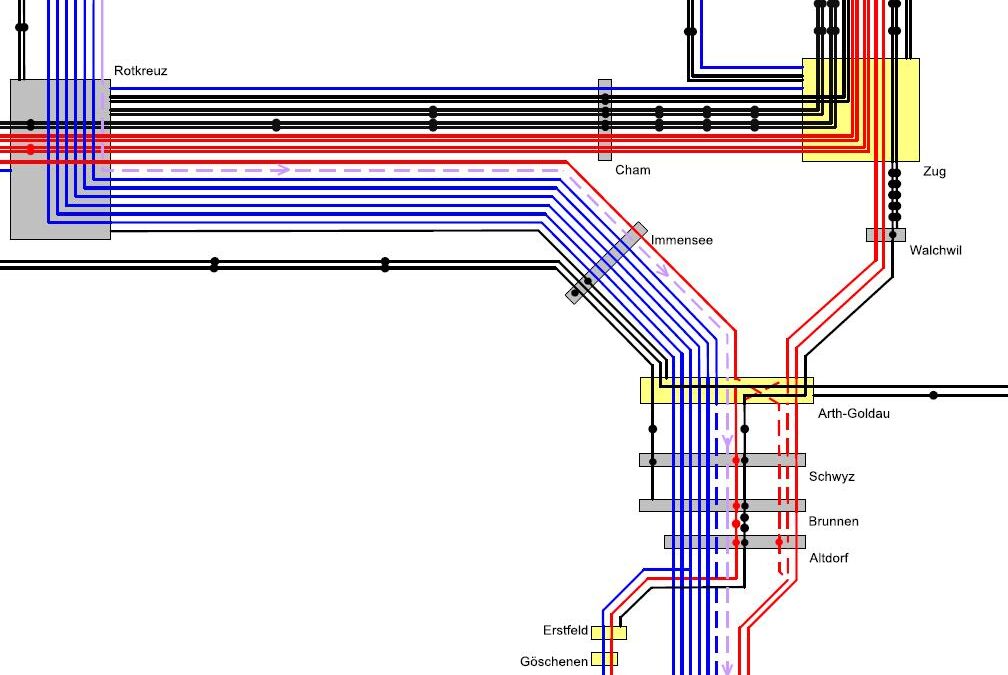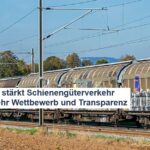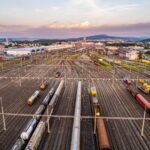That’s what it’s all about:
- Network utilisation concept and plan (NNK/NNP) secure train paths for goods trains in the long term
- Unused freight train paths – demand from passenger transport
- Motion 23.4259 Method for determining train paths for long-lasting construction sites
- Temporary flexibilisation only with binding agreement to solve the bottleneck
Network utilisation concept and plan (NNK/NNP) secure train paths for goods trains in the long term
As part of the «Financing the railway infrastructure» bill in 2013, infrastructure expansion targets for freight transport were defined in Art. 48a lit. b of the Railway Act (EBG). These include improvements for domestic, import and export traffic as well as improving the availability of train paths. As part of the draft revision of the Freight Transport Act, the so-called network utilisation concept and the network utilisation plan were introduced in 2015 as a means of securing available freight train paths. With these instruments, the long-term expansion and utilisation planning of the railway infrastructure is designed to ensure the availability of a minimum number of train paths per hour and direction on the various network sections for freight and passenger transport. The service concepts and rolling timetable planning must be developed along these available train paths. If, through skilful capacity planning in the timetable procedure, more train paths are ultimately available in the annual timetable than provided for in the NNK/NNP, they are also available to the train path allocation body for allocation.
Unused freight train paths – demand from passenger transport
As freight transport, unlike passenger transport, cannot be planned in the long term and depends on current market conditions, secured freight train paths are regularly not utilised. This is unproblematic as long as there are no conflicts with passenger transport. However, in the case of construction sites, as is regularly the case on the Swiss network due to ongoing expansion and necessary maintenance work, conflicts are practically inevitable. If freight train paths are actually not used in such constellations, the passenger transport industry and the cantons are understandably very unhappy.
Motion 23.4259 Method for determining train paths for long-term roadworks
With motion 23.4259, NR Cottier FDP/NE is asking the Federal Council for a method to improve the allocation of train paths in the event of long-term construction sites. The aim is to create the possibility of allocating unused freight train paths to passenger transport for the duration of construction sites. The Federal Council is asking Parliament to reject the motion, as the desired flexibility is provided by the current planning system. Unused freight train paths can be allocated to passenger transport.
Temporary flexibilisation only with a binding agreement to solve the bottleneck
The petitioner’s concern is understandable. The VAP has also signalled to the cantons on various occasions that it will not refuse the desired flexibilisation of train paths. However, this cannot mean a fundamental renunciation of securing freight transport routes à la longue. Rather, an appropriate solution must be agreed for each conflict on a case-by-case basis. In the case of structural conflicts in particular, for example as a result of unforeseen expansions in passenger transport services that are not of a temporary nature and therefore preclude the future safeguarding of the freight train path concerned, a corresponding structural solution must be agreed as part of the next expansion phase. However, this is legally difficult to implement, as it is Parliament that decides on the expansion stages and credits and not the affected cantons and industry representatives.
Possible solutions are currently being sought at a round table, using the example of the service between Neuchâtel and Geneva. The VAP will participate as a representative of customers, who can also order train paths, in an endeavour to find balanced solutions.
At the end of 2023, the FOT also started work on the evaluation of NNK and NNP. The aim is to evaluate the instruments that have now been in use for a considerable period of time with regard to any need for improvement. The VAP is actively involved in this working group.



